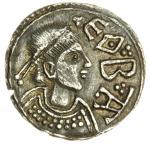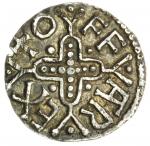Mercia, Offa (757-796), Penny, Light Coinage, Canterbury, Eoba, 1.26g, 3h, + O|FF|A R|EX, pellet cross inside lobed quatrefoil set upon a long cross fourch, pellets in angles, rev. diademed and cuirassed bust right, EBA before, trefoil stops before and between letters (Ruding [1819], pl. IV, no. 19; Lockett [1920], pp. 80 and pl. VIII, no. 15 same dies; Chick 112b this coin, cf. The Yorkshire Numismatist 3 1997, pp. 47, fig. 2 this coin; CEB 52; N.306; Spink 905), a deft edge nick at 8 oclock, otherwise of sound fabric with an attractively uniform dark cabinet tone, the classical portrait beautifully executed by a London die cutter on behalf of the Royal engraver, good very fine, of equal rarity and with an exemplary pedigree Provenance Private acquisition from M Rasmussen, 2016 LaRiviere, Spink 160, 10 October 2002, lot 972 - ?,800 Rasmussen FPL, 17 October 2001 Webb-Ware collection L R Stack, 22-23 April 1999, Sotheby (New York), lot 283 - ?,750 [Webb-Ware] Ridgemount, Spink 69, 20 April 1989, lot 33 - ?,400 Spink 31, 12 October 1983, lot 83 - an extremely rare type - ?,200 Spink Numismatic Circular, September 1977, no. 8241 Clonterbrook Trust, Glendining, 7 July 1974, lot 6 (plate) - ?000 Lockett, Glendining, 26-27 April 1960, lot 3564 (plate) - ?60 Reynolds, Sotheby, 4 May 1914, lot 6 (plate) - very fine and extremely rare - ?8.10.0 [Spink] Astronomer [McClean], Sotheby, 11 June 1906, lot 85 (plate) - very fine and of great rarity - ?1.0.0 [Spink] Montagu, Sotheby, 18 November 1895, lot 188 - very fine and extremely rare - ?1.10.0 [Money] Brice, collection purchased en bloc by Montagu, 1887 Bartolomeo Borghesi Museum, Part II, Raffaele Dura and Sambon (Rome), 24 April 1880, lot 1363 - DENARO. E.O.B.A. Busto a d. R. + O-FF-A R-EX negli spazi di una croce R.2 F.D.C. AR. ~ Rome Hoard, c. 1830 ~ The numismatic record testifies to the elevated position of the moneyer Eoba within the Mercian Royal court, and loans to us a great number of his issues from the earliest identified in the hegemons reign through to his Royal apogee - both artistically and imperially. As Gannon has noted: Offas coinage mirrors the richness of Anglo-Saxon art, stress[ing] the experimental, even the exotic, besides the traditional in some designs; thus one can postulate at the wealth of models available, and the taste and curiosity of the King. Evidently his trusted status, along with that of the contemporary moneyers Ealhraed and Lul(la), enabled Eoba to produce this dramatic series which simultaneously portrayed Offa in the guise of a Roman Emperor, as well as providing the official introduction of his Queen Cynethryth in a tandem issue. Previous interpretation has concluded that Eoba simply miscalculated the first renderings of the dies and mistakenly removed the Kings name to the reverse, whilst elevating his own to be that next to the portrait. Ealhraed is known to have performed the same feat on his own issue (Chick 92), before subsequent permutations restore the Royal precedent (Chick 93-98). However, there may be a more practical explanation for this mistake, with the obvious clue coming from the highly competent rendering of the King. This has evidently been cut by London diesmiths, and undertaken at a mint site where Offa could have more oversight of his prototype. As Naismith notes: Eoba highlights the directness with which Kings could at times take a hand in minting, but also that this role might be mediated through specific moneyers. As the procedure added a degree of separation to the usual minting procedure, and in advance of receipt of the new model, it is conceivable that the Canterbury moneyers pre-prepared their own reverse dies to marry with the new design. The realisation of the mistake in punching the Kings name into their own die, would only be noticed upon receipt of the London hubs, leaving the somewhat awkward fudge to further satisfy the need for the moneyers name to also appear on the new coin. This would account for the subsequent variants where the legends are swapped as the portraits begin to exhibit local engraving flair (Chick 93-98). There are however other possibilities for this somewhat bizarre marriage with a numismatic precedent found in the Sceatta series of portrait and moneyer types of the earlier 8th Century, as well as the Roman Republican issues of denarii that no doubt appeared to Saxon farmworkers as had the 4th century prototype which first inspired the design of the present coin. Perhaps these iconographic inspirations are also the very source of the metal used to produce this new and highly considered coinage. For Offa perhaps the creation of this portrait was not just a personal boast about being modelled as a Roman Emperor, but in fact a very real statement of his intent his world-view: the renewal, renovation and restitution of Imperial power under him. Bibliography: Rory Naismith, Money and Power in Anglo-Saxon England: The Southern-English Kingdoms - 757-865, pp. 151-152] Anna Gannon, The Iconography of Anglo-Saxon Coinage: Sixth to Eighth Centuries, pp. 169



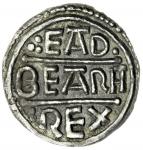
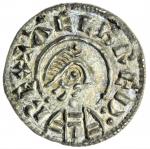

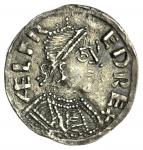



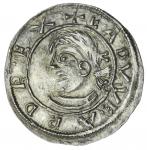

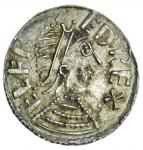

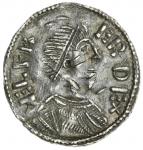
![Danelaw, Viking Kingdoms, Cnut of Northumbria (c. 900-905), Penny, 1.34g, 6h, [York], C N V T R E X](http://data.shouxi.com/upload/img/d5/14/d514ef7b1e6f40a649c3afbc504186a0_150x150.jpg)


